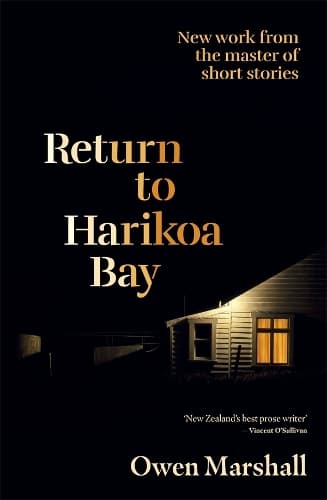Review: Return to Harikoa Bay
Reviewed by Sam Finnemore
The cover of Owen Marshall’s Return to Harikoa Bay celebrates “new work by the master of short stories.” It’s true that Marshall’s short stories have carved out a space in local literature where it can be hard to judge them by any standard other than that of the Owen Marshall story. In their precise, sombre prose and piercing observation across all corners of New Zealand life, they’re an institution in themselves even aside from the rest of Marshall’s output.
The qualities behind their success are no less impressive for being familiar in this new collection. Return to Harikoa Bay features 33 stories in around 300 pages, each with an intricacy that makes it hard to believe they’re standalone works; there’s the sense of a novel’s worth of planning and thought beneath the iceberg tip of the finished piece, often pared back to a single character turn or inciting incident.
With a few striking exceptions later in the collection, few of these stories are powered by force of events alone. It’s the way characters remember, interpret and respond that remains Marshall’s main focus. Most are first-person reflections (sometimes confessions) from characters on the far side of midlife. Career changes, whether voluntary or otherwise; getting out of a relationship or back into one; relationships between parents and adult children – Return to Harikoa Bay contains, as the joke runs, mature themes. The title story is a case in point, switching fluidly between both sides’ perspectives on a marriage that’s quietly and genteelly falling apart.
Memory and looking back on the past are key themes across the collection, perhaps reflecting the age of the protagonists, but there are some striking exceptions to the pattern. The Light Fandango exchanges the mild-mannered, reflective voice of many Marshall protagonists for that of a profane, calculatedly blokey dropout artist, developing a ‘coital energy process,’ sparring with his landlord and writing to rich-listers to secure patronage: ‘Only Sir Whitby Frottager replied. He told me to get a job, but when I said I was happy to accept one, I didn’t hear back. Typical.’
Marshall’s third-person writing can be nevertheless intimate and affecting (Rue de Paradis) or take on a satirical edge. In the opening Resurrection of the Dolls, this leans into outright breaking of the fourth wall. Other People follows an academic expert on Sartre through a routine day on campus, with a punchline that’s somehow both inevitable and brilliantly underplayed.
Work, in fact, crops up a lot in these stories, often with a note of subterfuge, mystery or the pressure of maintaining appearances; a disgraced lawyer drawn back into an employment dispute on the factory floor, the mysterious background of a boarding-school caterer. Sometimes it recedes into the background as an amusing character twist (a widowed dentist assesses future partners at least in part by the state of their teeth). Sometimes, as in The Undertaker’s Story, it’s rather more plot critical.
As that last title suggests, parts of the collection depart from more mundane happenings to take a darker turn. What Eddy Sees reveals character through a police interview transcript that turns from diffident to hostile. In other places there’s an abiding, macabre strangeness: what does it mean to cut off your own finger on the instruction of a dream or to keep and wear the penguin cap dropped by a customer who had a heart attack in your bookstore?
The collection’s jacket billing as ‘superbly subversive’ fits not just its observation of the hidden corners of human behaviour, and our rationalisation of experiences and memories, but Marshall’s reflexive attention to the nature of his own storytelling. Behind the Scenes takes in layers of memory from an elderly man walking around Christchurch, each of which could well have been a story in its own right – and as Marshall suggests, many more waiting in the wings: ‘Where else should we accompany Richard? There are so many choices.’
Return to Harikoa Bay might not be avant-garde, but work of this quality doesn’t come easily; Marshall is fully in control of his craft and in the awareness of that mastery there’s playfulness and a continuing capacity to surprise.
Reviewed by Sam Finnemore
